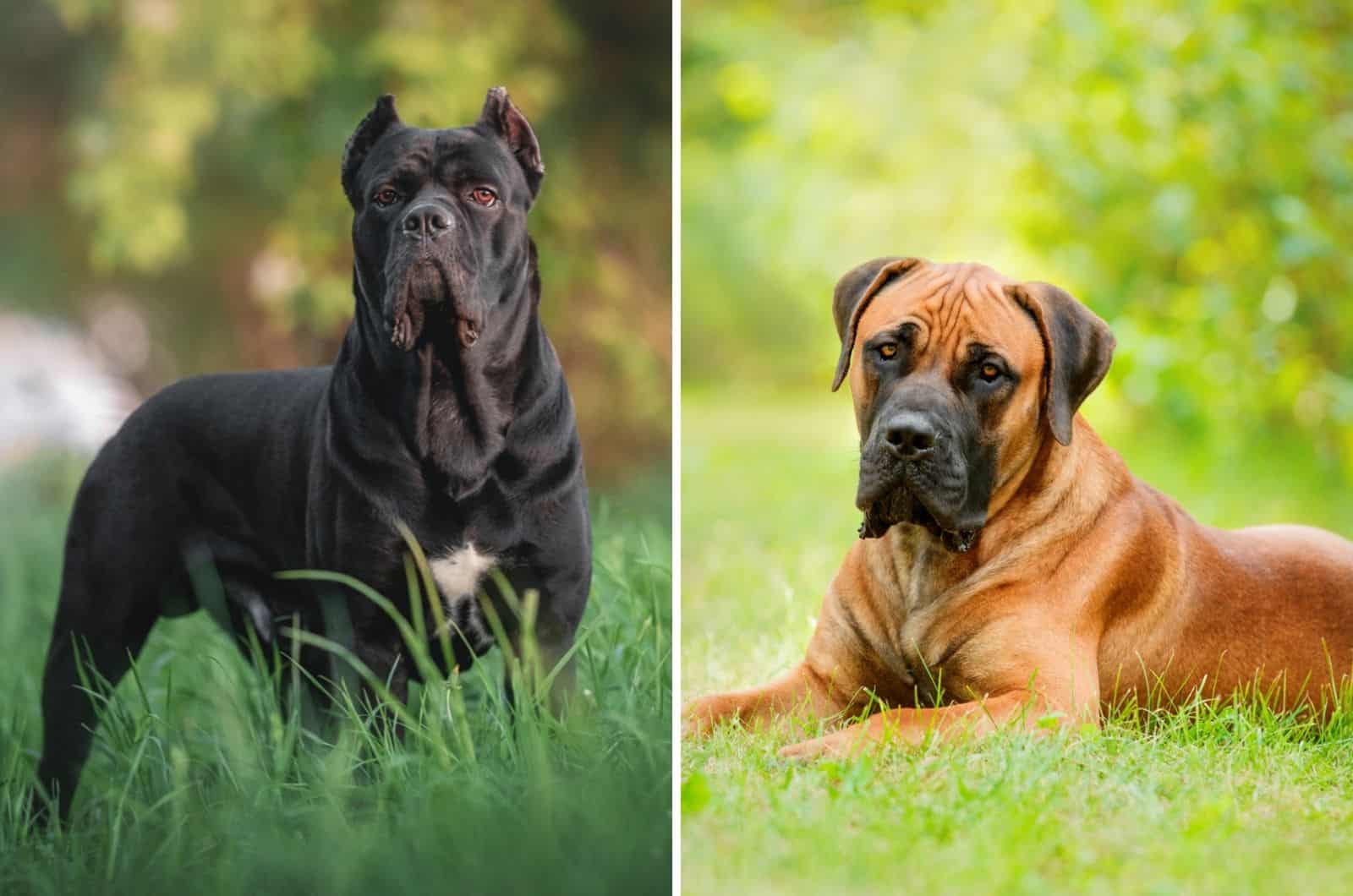If you’re a fan of large dog breeds, you’re spoiled for choice! There are so many amazing big dogs out there, each with its own unique qualities.
We’re looking at two of these giants to see which might be the best option for you: the mighty Cane Corso or the magnificent South African Boerboel?
Both are Mastiff breeds (the Cane Corso is also called the Italian Mastiff, and the Boerboel is known as the South African Mastiff), so what separates the two and makes one better than the other?
We’ll examine each quality to discover any differences, strengths, weaknesses, and similarities to equip you with everything you need to make a decision.
Cane Corso Vs. Boerboel: Size
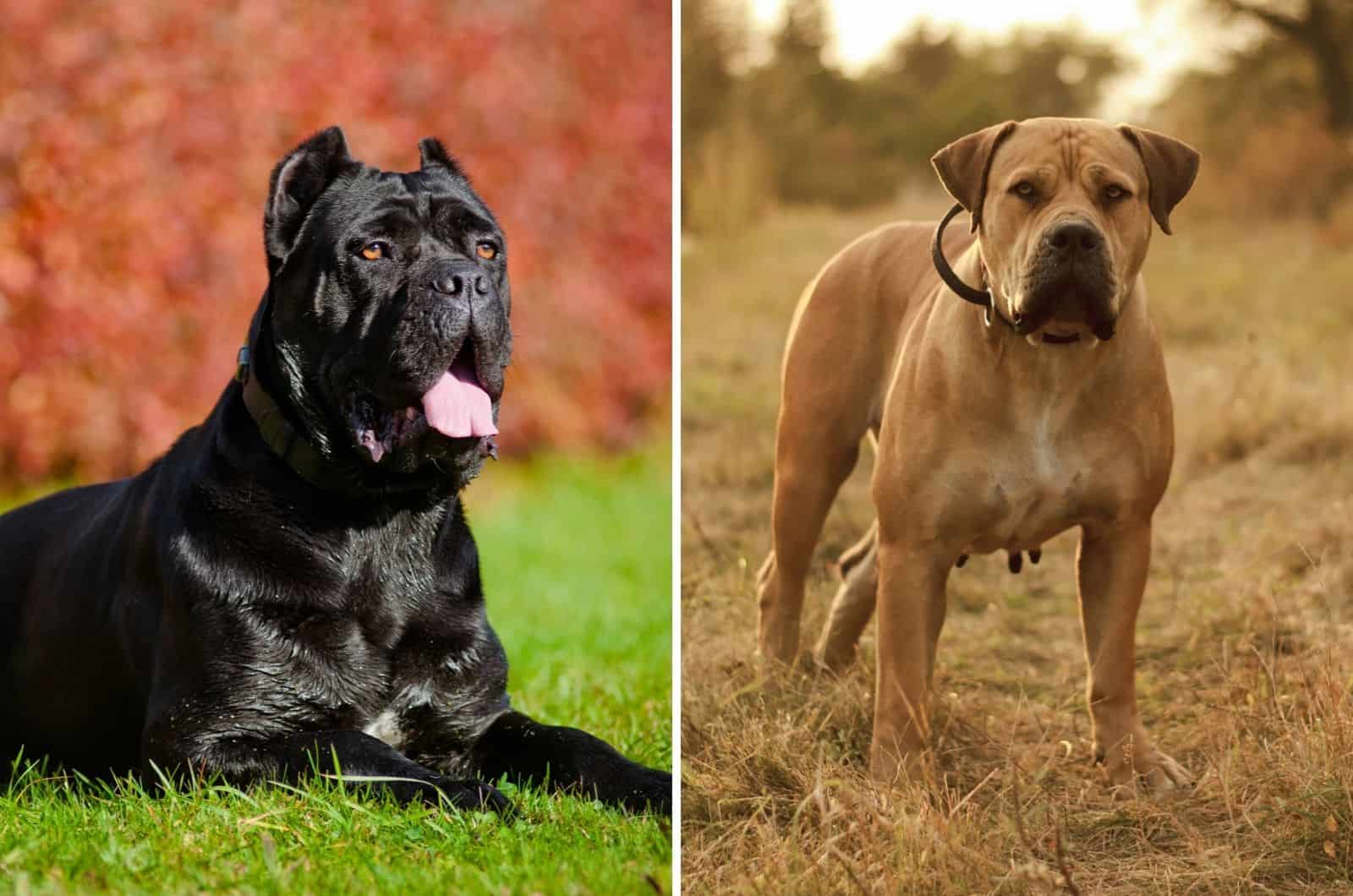
How big are these majestic beasts?
Let’s find out with this table showing the average sizes of full-grown adult dogs:
Height Weight
Cane Corso male 25 to 27.5 inches 110 to 140 pounds
Cane Corso female 23.5 to 26 inches 88 to 110 pounds
Boerboel male 24 to 27 inches 150 to 200 pounds
Boerboel female 22 to 25 inches 150 to 200 pounds
As you can see, the Cane Corso just about wins in terms of height – you can check the Cane Corso growth chart here – though the Boerboel is definitely the heaviest of the two.
Both of these powerful dogs will get through a lot of food in their lifetime, though the Boerboel is likely to be the bigger eater of the two.
This is well worth keeping in mind when working out a dog food budget.
Cane Corso Vs. Boerboel: Prices
The average cost of a Cane Corso puppy is around $1,500, and this will get you a healthy pup from a pretty decent bloodline. You can pick one up for as little as $700, or you can pay upwards of $4,000, and you might even see them on sale for $9,000.
It all depends on the pedigree, bloodline, and the breeder’s reputation. However, if you set your budget around $1,000 to $2,000, you’ll get a good quality dog.
In general, the Boerboel costs a little more than the Corso, with pups going for between $2,000 and $4,000. Again, it depends on the bloodline and the Boerboel breeder, but $2,000 will secure a healthy puppy.
Cane Corso Vs. Boerboel: Temperament
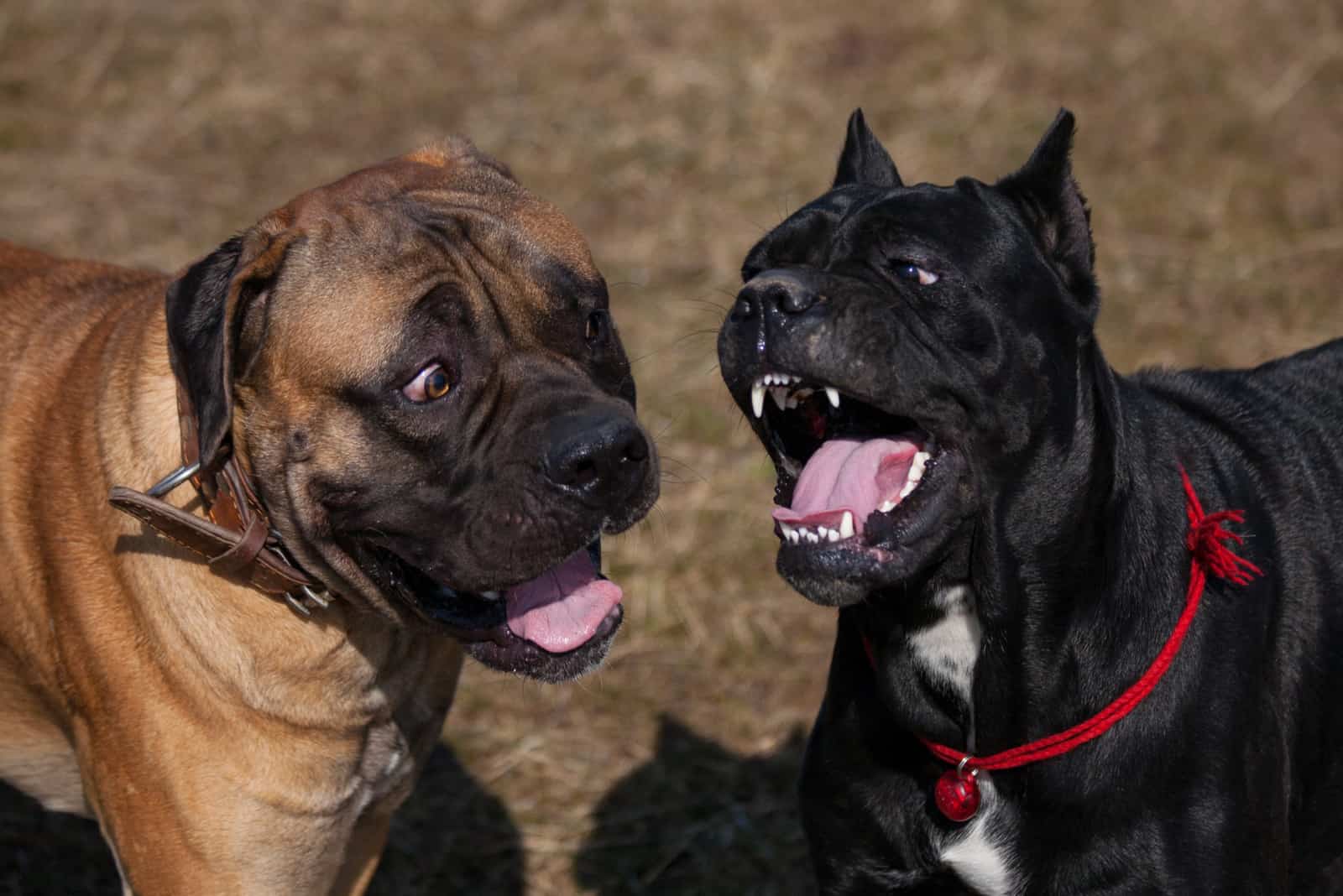
As working dogs, both breeds were created for a specific reason, and this has a bearing on their temperament:
Cane Corso
These mighty dogs originated in Italy, descended from Roman war dogs, and the Molosser dogs of ancient Greece before that.
Once the Roman Empire had fallen, this giant breed of dog found use as a guardian on Italian farms, watching over flocks, the property, and its owners. Because of their size, courage, and powerful bodies, they also became valued as hunting dogs, helping to bring down wild boars.
These days, the Cane Corso is still a faithful guardian (their name means guardian dog) though most are family dogs. Much of the aggression of the past has been bred out of them, but they are still intimidating, especially if roused to anger when anything threatens their family or property.
The typical Italian Mastiff is loving and affectionate to its owners, calm, reserved, and even-tempered. They remain watchful and alert at all times, ready to protect their family if needed.
They are mostly docile and safe around kids, though you should always supervise any interaction. The main danger is their size, as they could knock a child down by accident.
They have a playful side, but for the most part, they will be serious. There’s also a good chance that they’ll try to muscle in and take charge, which is why they need an assertive owner to impress their authority at all times.
Finally, Cane Corsi are relatively easy to train as they are eager to please you and highly intelligent.
Boerboel
The Boerboel comes from South Africa, where it was used for herding and as a guard dog, protecting homesteads and families from wild beasts.
Their name means farmer’s dog in Afrikaan. This name was used in the early 19th century to describe a cross between the Mastiff and the Bulldog bred by Dutch farmers that had settled in the country.
These dogs are fiercely protective and territorial by nature, though they are gentle, affectionate, and playful with their family members. Nothing matters more to them than family!
They can be especially protective of children, so it is best to avoid letting your kid have friends over. If playtime gets too noisy or rough, they may believe that your child is being harmed, and there’s a chance they’ll intervene.
Likewise, when you have visitors, introduce them to your dog to let them know they aren’t a threat. Your pooch may remain aloof, but they’ll accept your guest’s presence without a fuss.
Like all intelligent dogs, the Boerboel loves to have a job to do. Nothing makes them happier than keeping busy!
The Boerboel’s only major sticking point is their tendency towards stubbornness. This can make training them a real chore, as they prefer to turn it into playtime. They’re also bossy dogs that will always try to get the upper hand.
As with the Cane Corso, you need to stamp your authority on the relationship early and maintain your position as pack leader.
The Importance Of Socialization And Training
Whichever of these two giants you choose, you can make your life much easier by socializing your puppy at the earliest opportunity.
All the best dog breeders start socializing their pups by the time they are three weeks of age, continuing the process until they leave the litter between 8 and 12 weeks of age.
If you take up the reins and ensure that your pup is exposed to various situations, people, and other animals, they’ll be better equipped to assess whether there is a threat or not.
A Boerboel or Cane Corso puppy that has been properly socialized is highly likely to be more accepting of other dogs and strangers than one that hasn’t been socialized at all.
The same applies to training, as you need to have control over your dog at all times. If your pooch takes a dislike to something or someone and decides to take action, there’s very little you can do to stop it, no matter how strong you believe yourself to be.
These massive dogs can weigh between 100 and 200 pounds, and they are extremely strong and muscular.
You must be able to stop them using a command word rather than rely on physical strength to pull them back.
Boerboel Vs. Cane Corso: Health Issues
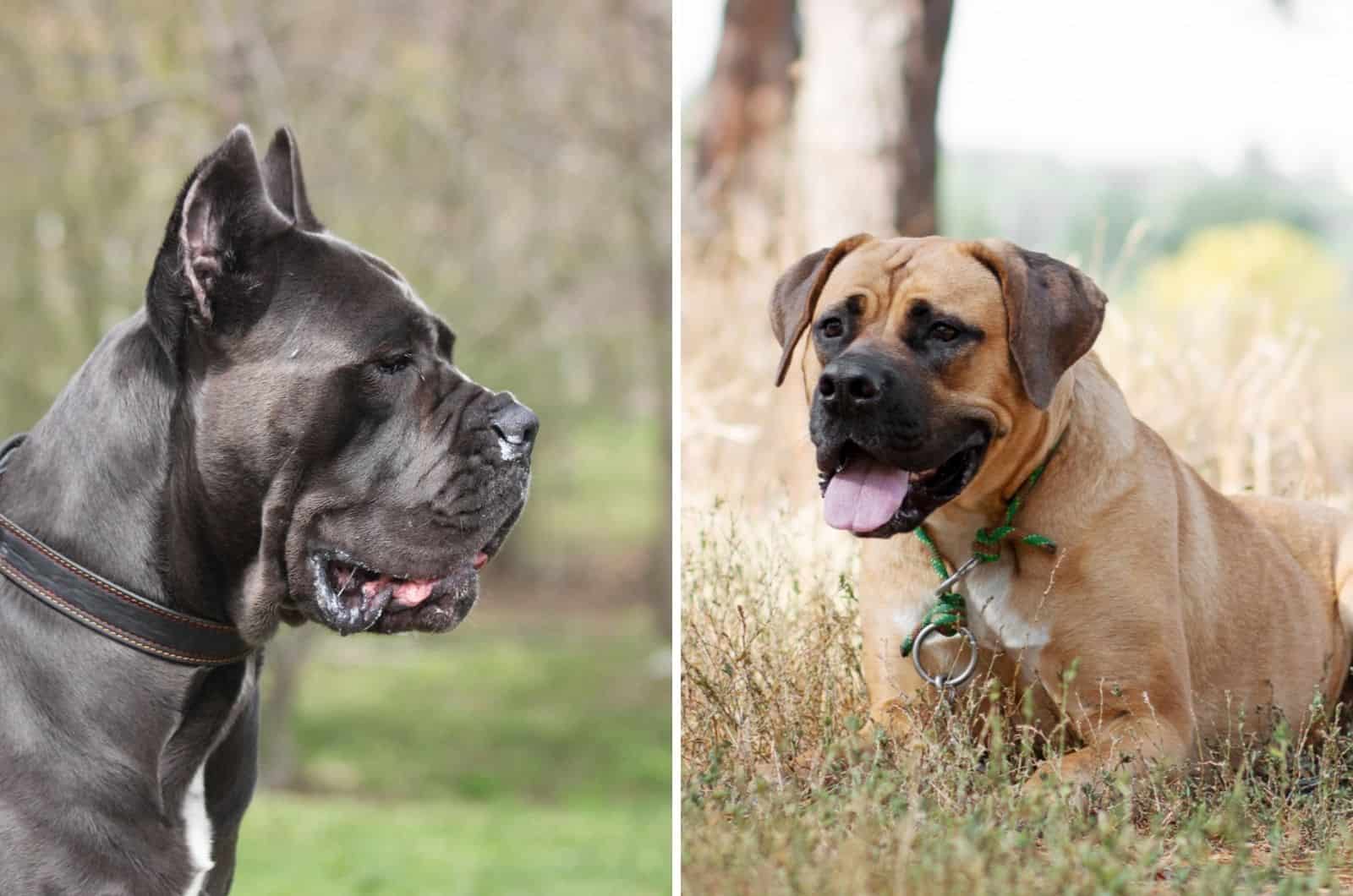
Every dog owner wants their furry companion to be healthy, but we all know that sometimes your furry best friend gets sick.
There’s an added dimension with large breeds: the bigger the animal, the higher the vet bill.
As if the worry of having a sick pet wasn’t enough, the impact on your finances can be significant. Many dog owners take out pet insurance to help relieve the burden, but it can still take its toll.
Let’s look at some of the common health conditions that these dogs face:
Cane Corso
Here are some common Cane Corso health issues:
• Hip dysplasia
• Bloat
• Entropion (the eyelid turns inward, causing eyelashes to rub against the cornea)
• Ectropion (similar to the condition above, but the eyelid is turned outward)
• Cancer
• Allergies
• Cherry eye (caused by an inflamed tear gland in the third eyelid)
• Boerboel
Below are some health problems you can expect in Boerboels:
• Hip dysplasia
• Elbow dysplasia
• Bloat
• Patella luxation (loose kneecap)
• Epilepsy
• Heart conditions
• Skin infections
Conditions like elbow and hip dysplasia are found in many dog breeds, especially large dogs. The problem is basically a result of decades of line breeding to preserve a specific breed standard. Because of this, some dogs have badly formed joints where the bones don’t fit together well, making bone grind against bone.
Many dogs with this condition develop arthritis later in life.
These issues can be costly to fix as they often require surgery, which carries a fee of between $3,500 and $7,000 per hip.
Both of these giants can also suffer from cruciate ligament* problems, essentially due to their size.
*located in the knee joint. These can rupture when put under pressure.
Of all the health problems listed here, bloat (which affects both breeds) is potentially the most serious. Also known as gastric torsion and GDV, this condition affects large, deep-chested dogs and usually occurs after eating or drinking excessively, especially before or after vigorous exercise.
The dog’s stomach swells with gas or liquid, trapping these substances inside. In many cases, the dog’s stomach begins to twist around and takes the pancreas with it. Blood flow to the dog’s vital organs is obstructed, and the pancreas acts strangely, pumping out toxic enzymes that can stop the dog’s heart.
Organs starved of blood begin to necrotize, basically meaning that the tissue is dead.
Without emergency surgery, the dog is unlikely to survive. The good news is that the prognosis these days is better than in the past, provided the dog is treated in time.
Cane Corso Vs. Boerboel: Lifespan
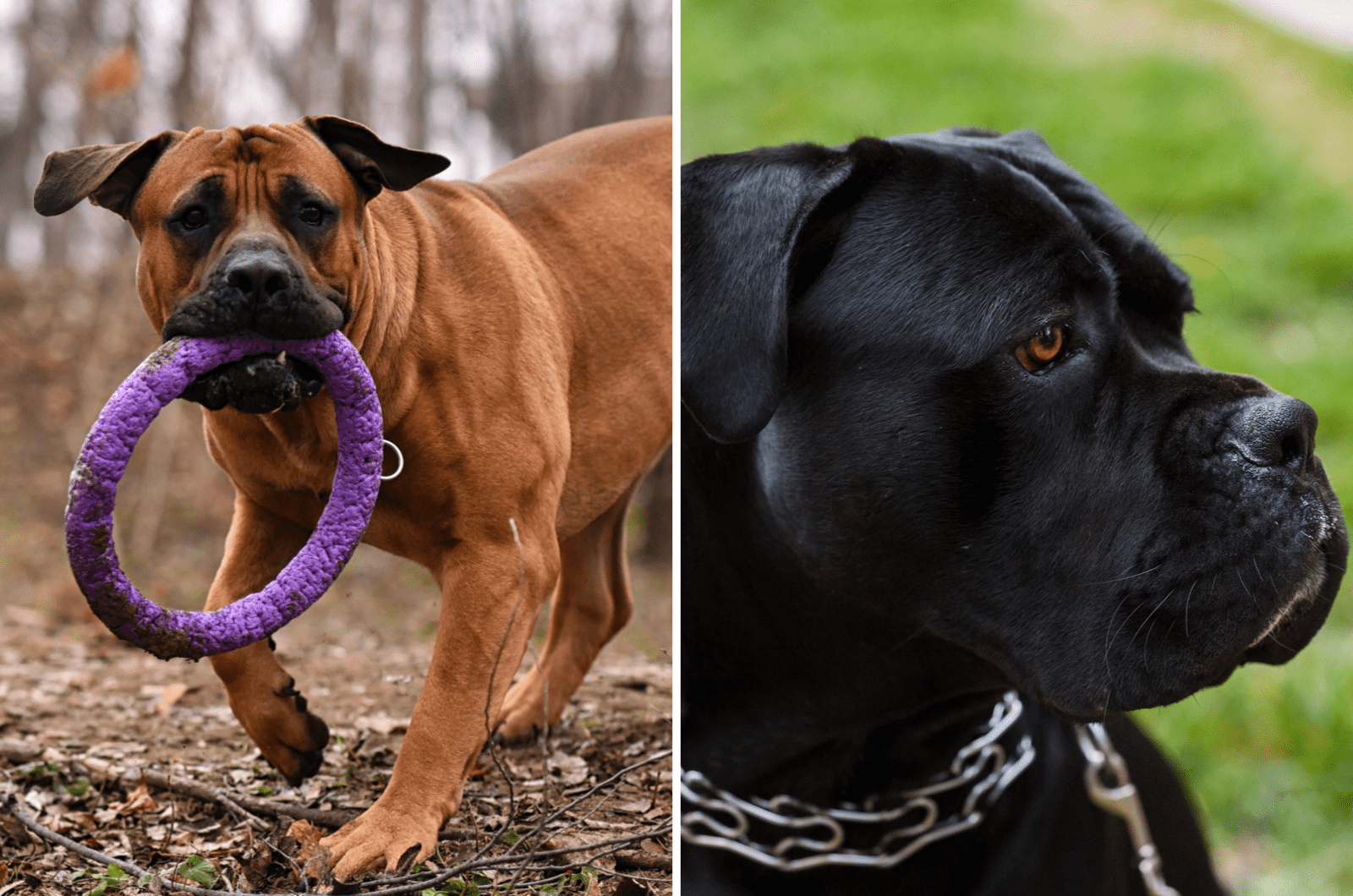
Longevity can be a problem for large dog breeds, and in general, they tend to live shorter lives than their smaller counterparts.
Consider the lifespan of breeds like Chihuahuas, Yorkies, and Toy Poodles that regularly reach 20 years or more!
The average dog breed has a lifespan of between 10 and 13 years.
So, how do our two giants fare in terms of longevity?
The American Kennel Club (AKC) puts the Cane Corso’s lifespan at between 9 and 12 years and the Boerboel between 9 and 11 years: both fall roughly in the average for all dog breeds.
This isn’t too bad, considering breeds such as the Great Dane, Mastiff, Bullmastiff, and Bernese Mountain Dog, which live between 5 and 8 years!
There’s no clear winner between the Cane Corso and Boerboel in terms of lifespan. Still, you can improve your dog’s chances by using a reputable breeder and providing your pooch with a healthy diet, lots of exercise, and regular health checks.
Boerboel Vs. Cane Corso: Coat Type And Colors
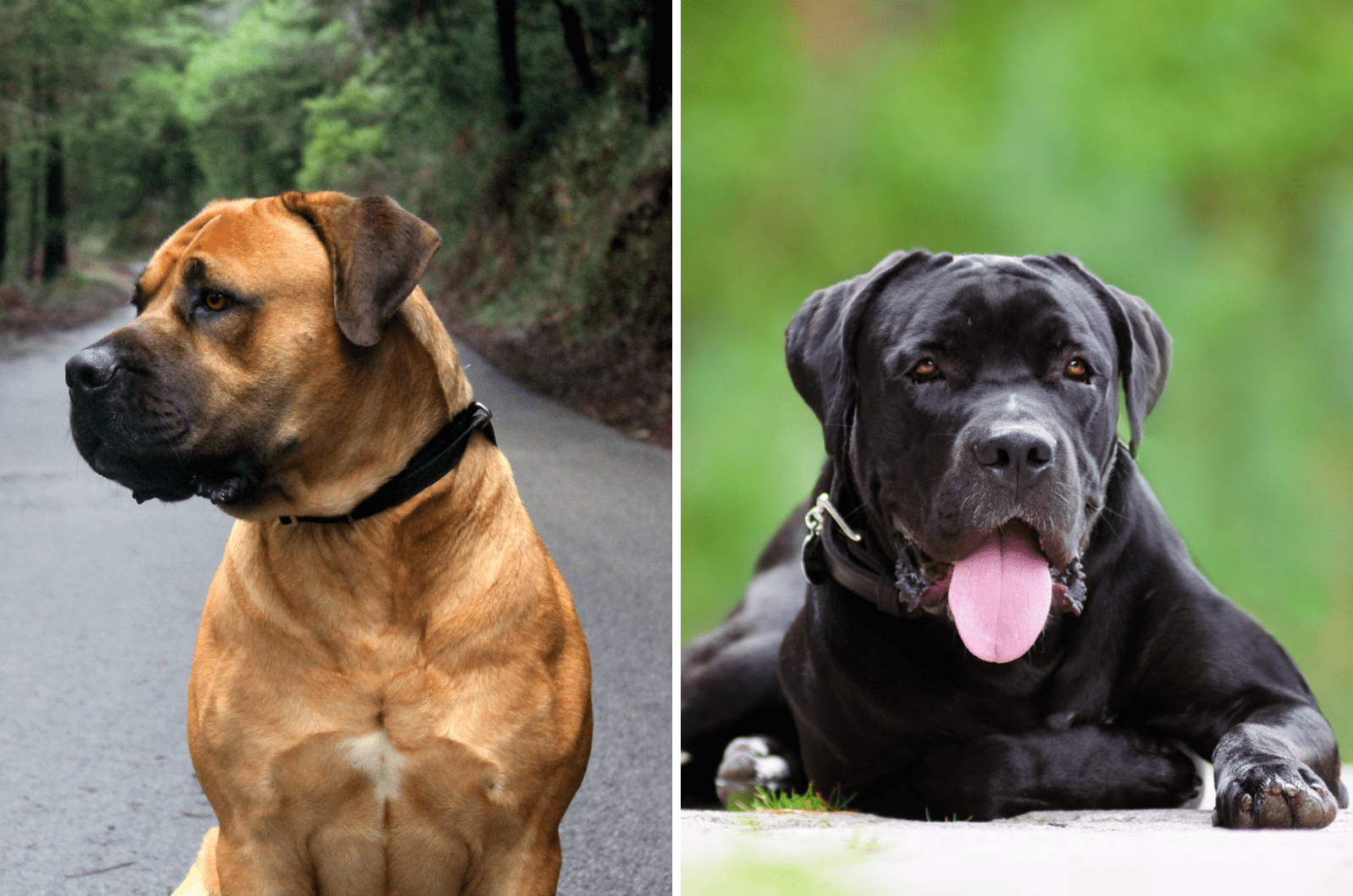 Both breeds have smooth short coats that are pretty easy to manage, so their grooming needs are low. You won’t have anywhere near the same amount of dog hair as you would with, say, a German Shepherd!
Both breeds have smooth short coats that are pretty easy to manage, so their grooming needs are low. You won’t have anywhere near the same amount of dog hair as you would with, say, a German Shepherd!
Cane Corso shed lightly all year round, with a slight uptick in shedding in spring and fall. They are not hypoallergenic.
Boerboels shed moderately all year, with a similar increase during the shedding seasons.
In either case, shedding can be managed with a weekly brush using a grooming mitt or curry brush. The best brush for Cane Corso will also work amazingly for Boerboels.
Bathing Your Dog
The main issue here is your dog’s size, which presents more of a challenge when you decide to bathe them! Neither dog needs bathing any more than once a month unless they become particularly filthy in the meantime.
During the summer months, it’s best to wash your dog outdoors, but this isn’t practical in winter. If your shower or bathtub is big enough, you can bathe your pooch here. If not, you might consider using a professional groomer for the task.
Keep in mind that if your dog isn’t dirty or smelly, they really won’t need washing. Dry, loose dirt can be brushed out, keeping your dog’s coat clean and smooth.
When you do was your dog, only use mild, dog-safe shampoo. Never use a hair dryer designed for humans to dry your dog as they get too hot and may burn its skin.
Now let’s look at coat colors!
Boerboel Colors
There are six standard colors and four standard markings for the South African dog:
Colors
• Tawny
• Brindle
• Brown
• Cream
• Reddish-brown
• Red
Markings
• Irish marked
• Piebald
• Black mask
• White markings
Cane Corso Colors
The Italian Mastiff has seven standard colors and only two standard markings:
Colors
• Fawn
• Black
• Black brindle
• Gray brindle
• Chestnut brindle
• Red
• Gray
Markings
• Gray mask
• Black mask
On the whole, there’s a good mix of colors between the two breeds, though the Cane Corso colors are generally darker. Many Corso owners opt for the glossy black coat as it imparts a sense of power and mystery with sinister overtones.
Boerboels often come in brown or tawny shades, but don’t be fooled: they can be every bit as daunting as their Italian counterparts!
Cane Corso Vs. Boerboel: Exercise Needs
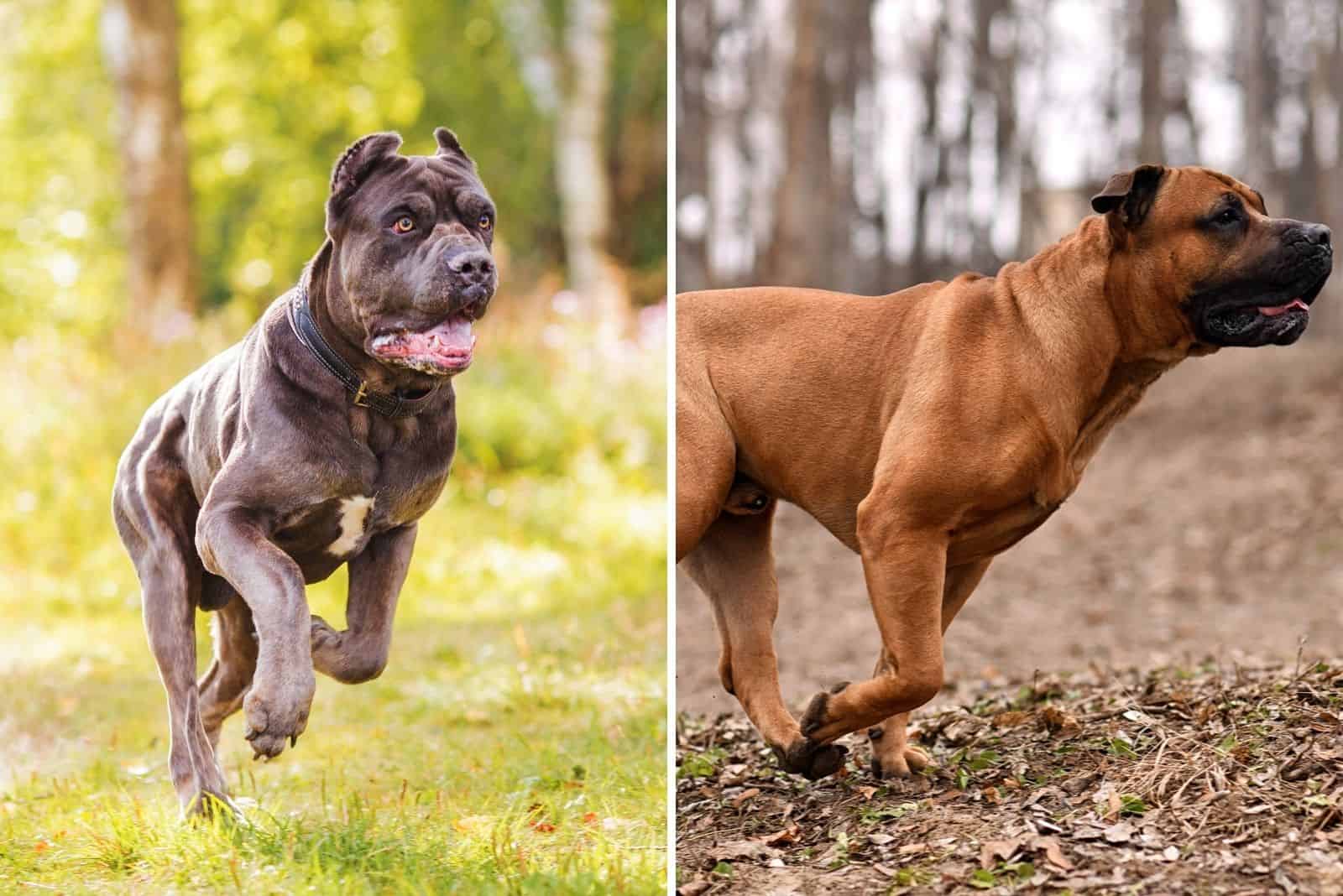
All dogs need regular daily exercise for their physical and mental health, and this counts double for two such big and powerful dogs. Without mental stimulation, they can become aggressive and destructive. And without adequate exercise, they will rapidly gain weight, leading to health complications.
Of the two breeds, the Cane Corso is the more athletic, needing around two hours of exercise every day to use up their energy levels and keep those muscles toned.
The Boerboel requires an hour or more to satisfy its exercise needs.
Exercise should take the form of long walks and runs, split into half-hour sessions throughout the day.
It’s worth mentioning at this point that the Cane Corso faces restrictions and bans in some states and cities, so be sure to check with your local authority, or you may risk a fine or have your dog seized by animal control.
This is relevant here because many experts recommend that you never let your Corso off the leash in public spaces. However, you must have a secure area for your dog to explore, run, and play without being restricted by a leash.
Likewise, the Boerboel needs to be kept on a leash in public areas but doesn’t face the same restrictions as the Cane Corso.
Cane Corso Vs. Boerboel Bite Force
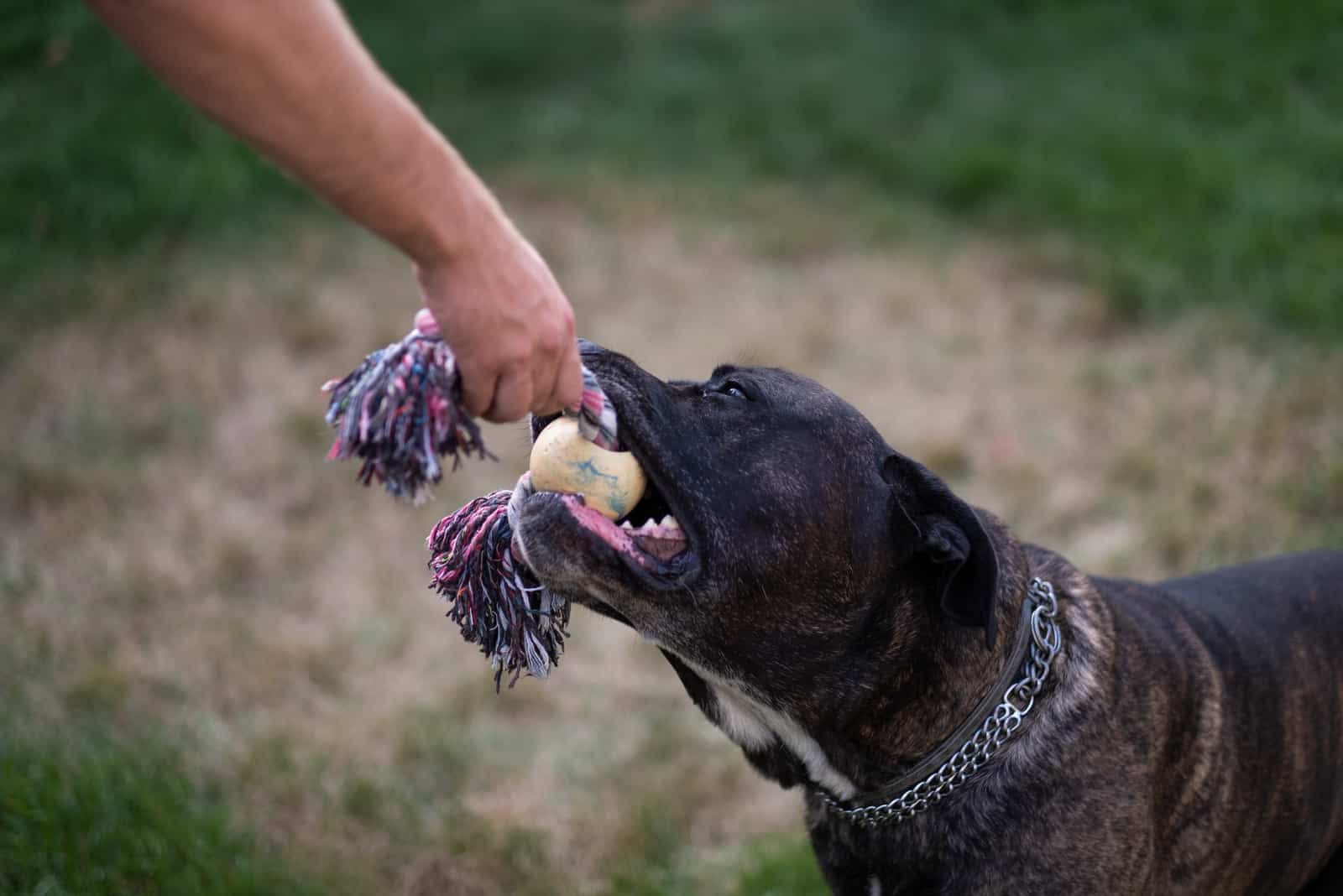
Which dog has the most powerful bite?
Well, the average bite force of any dog is between 230 and 250 PSI. That’s pounds of pressure per square inch. So, if a dog bites you, every square inch feels as if it has around 230 pounds pressing down on it, to put it in simple terms.
That’s more than enough to tear flesh, and even break bones in some cases, especially when small kids are involved.
In comparison, the Boerboel’s bite force is around 450 PSI, almost twice as much as the average. As for the Cane Corso, they have a bite force of a staggering 700 PSI!
If you don’t think that’s impressive, consider this: a standard house brick breaks at 700 PSI, and lions have a bite force of about 650 PSI.
It might seem odd that we included this comparison, but it’s relevant to our mission to discover the differences between these two big dogs.
While small dogs are more likely to bite their owners (the Dachshund being the worst culprit!) as well as generally being more aggressive, a large dog does more damage, even if it bites you only once.
Also, this information gives you some idea of the dog’s immense strength. This is pretty sobering stuff and may help dog owners to understand the heavy burden of responsibility: it’s down to you to ensure that your dog never presents a danger to anyone or anything, whether family members, friends, the public, or other animals.
Cane Corso: A Dangerous Dog?
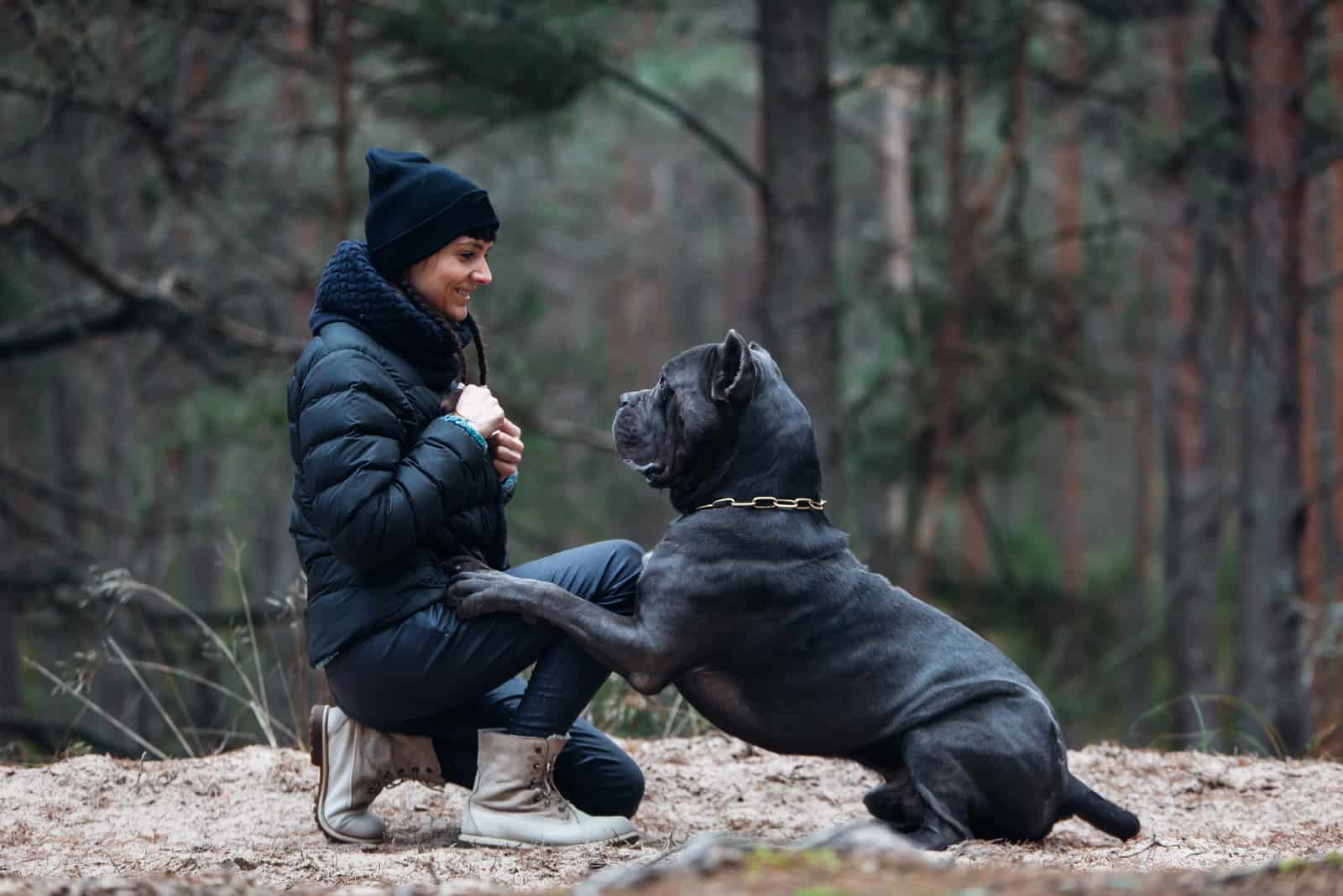
Although both these breeds are enormous, have an incredibly powerful bite force, and a natural protective instinct, only the Cane Corso faces restrictions and bans in the US. This can make people think that Cane Corso is an aggressive breed, or at least the more aggressive of the two.
Out of the fifty states, thirty have breed-specific legislation (BSL) in place, placing the Corso in with others like the Dogo Argentino, Presa Canario, Pitbull, Doberman, and Rottweiler.
The merits of BSL are debatable, and many dog lovers and experts have fought against these laws.
This legislation affects our mission here, as your decision between these two amazing breeds may be directly affected by your local authorities’ attitude towards the Cane Corso. Some cities and states have an outright ban on specific breeds, while others stipulate that the dogs are muzzled or kept on a leash.
The Boerboel, oddly enough, isn’t subject to any BSL, so you won’t have to worry that you’re breaking any laws by taking your dog out for a walk.
The main problem for the authorities seems to be the Corso’s immense bite force. Statistics show that between 2005 and 2017, Cane Corsos were cited in 21 attacks and two deaths.
When you consider that there are approximately 4.5 million (reported) dog bites each year, that doesn’t seem too bad. In the same period, English Bulldogs attacked 21 people and were responsible for one death, and they are not restricted by BSL!
Still, the law stands at the moment, and it’s an issue that you’ll have to consider when making your choice.
The Last Word
When comparing two breeds, it always seems wrong somehow to say that one of them is the best dog. Both are great breeds, and it depends on what you want in a dog as to whether one is better than the other for you personally. You might even get a Cane Corso Boerboel mix if you can’t make up your mind!
It’s essential to note that both breeds require a firm hand and an assertive personality. These breeds are not recommended for first-time dog owners.
On balance, they are both better suited to households with no kids, though they may be okay with older children. That’s not to say that they are necessarily a danger, but the risk of being knocked down (especially by the more playful Boerboel) is pretty high.
These are not apartment dogs. Both breeds need a secure space to run around and expend some of their energy.
As we’ve seen, the Cane Corso faces prejudice in the form of BSL that may have a bearing on whether you can buy one or not.
Grooming isn’t a problem with either dog, but the Corso requires twice as much exercise as the Boerboel. Basically, it comes down to which personality you prefer. Both breeds need commitment, effort, and a lot of care.
So, we’ve explored both of these giant dogs and highlighted their qualities. Now it’s up to you to decide!
And if you cannot choose between the two – you can always opt for a Cane Corso Boerboel mix and get the best of both worlds!
